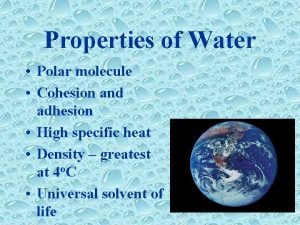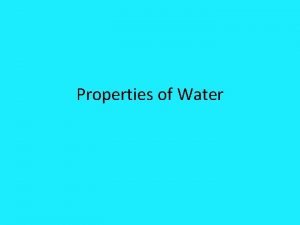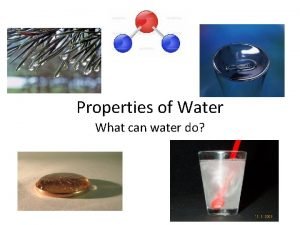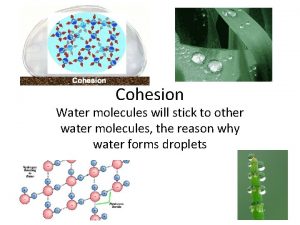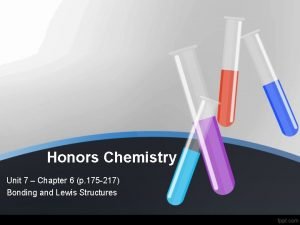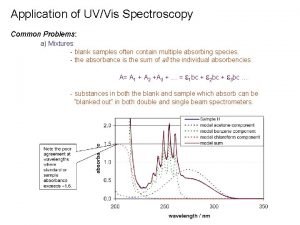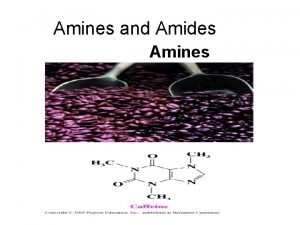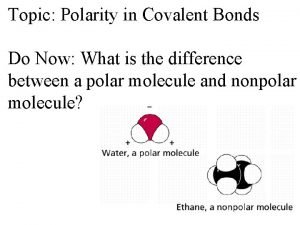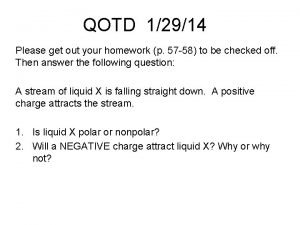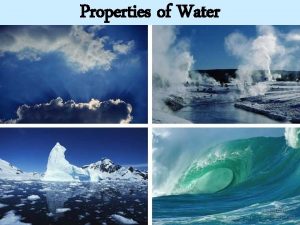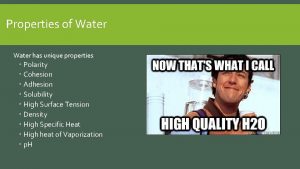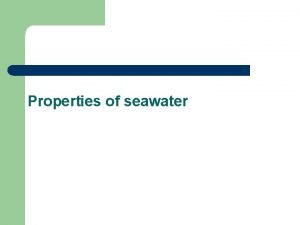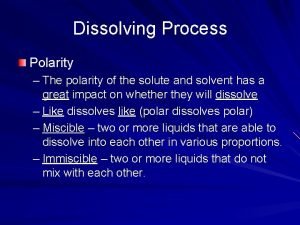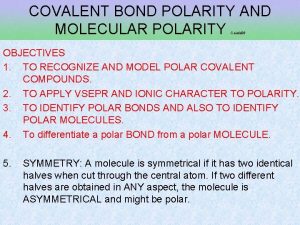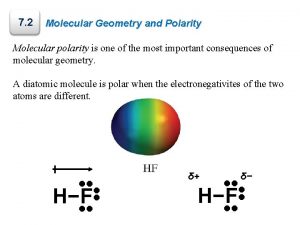Properties of Water Properties of Water Polarity Cohesion





















- Slides: 21

Properties of Water

Properties of Water • • • Polarity Cohesion Adhesion Surface Tension Specific Heat Density Universal solvent Salinity Properties of Water Video

Polarity of Water • A water molecule is a molecule with opposite ends of having opposite charges. • In a water molecule two hydrogen atoms form single polar covalent bonds with an oxygen atom. – Because oxygen is more electronegative, the region around oxygen has a partial negative charge. – The region near the two hydrogen atoms has a partial positive charge. • Gives water more structure than other liquids • Polarity Video

• Water has a variety of unusual properties because of attractions between these polar molecules. – The slightly negative regions of one molecule are attracted to the slightly positive regions of nearby molecules, forming a hydrogen bond. – Each water molecule can form hydrogen bonds with up to four neighbors.

HYDROGEN BONDS • Hold water molecules together • Each water molecule can form a maximum of 4 hydrogen bonds • The hydrogen bonds joining water molecules are weak, about 1/20 th as strong as covalent bonds. • They form, break, and reform with great frequency • Extraordinary Properties that are a result of hydrogen bonds. – – – Cohesive behavior Resists changes in temperature High heat of vaporization Expands when it freezes Versatile solvent

Organisms Depend on Cohesion The clinging together of particles of the same substance, a phenomenon called cohesion • Cohesion is responsible for the transport of the water column in plants • Cohesion among water molecules plays a key role in the transport of water against gravity in plants • Adhesion, clinging of one substance to another, contributes too, as water adheres to the wall of the vessels.

• Surface tension, a measure of the force necessary to stretch or break the surface of a liquid, is related to cohesion. – Water has a greater surface tension than most other liquids because hydrogen bonds among surface water molecules resist stretching or breaking the surface. – Water behaves as if covered by an invisible film. – Some animals can stand, walk, or run on water without breaking the surface.

Moderate Temperatures on Earth Water stabilizes air temperatures by absorbing heat from warmer air and releasing heat to cooler air. Water can absorb or release relatively large amounts of heat with only a slight change in its own temperature. Celsius Scale at Sea Level 100 o. C Water boils Fahrenheit Scale at Sea Level 212 o. F Water boils 37 o. C 98. 6 o. F 23 o. C Human body temperature Room temperature 70 o. F Human body temperature Room temperature 0 o. C Water freezes 32 o. F Water freezes

Specific Heat is the amount of heat that must be absorbed or lost for one gram of a substance to change its temperature by 1 o. C. Three-fourths of the earth is covered by water. The water serves as a large heat sink responsible for: 1. Prevention of temperature fluctuations that are outside the range suitable for life. 2. Coastal areas having a mild climate 3. A stable marine environment

Evaporative Cooling • The cooling of a surface occurs when the liquid evaporates • This is responsible for: – Moderating earth’s climate – Stabilizes temperature in aquatic ecosystems – Preventing organisms from overheating

Density of Water • Density, is also known as "specific gravity". – The mass per unit volume of a substance. • As long as an object is made up of molecules, and thus has size, it has a density. • Density is just the weight for a chosen amount (volume) of the material. • The density of water at room temperature is 1 gram/cm 3

Density of Water • Most dense at 4 o. C • Contracts (shrinks) until 4 o. C • Expands (grows) from 4 o. C to 0 o. C The density of water: 1. Prevents water from freezing from the bottom up. 2. Ice forms on the surface first—the freezing of the water releases heat to the water below creating insulation. 3. Makes transition between season less abrupt.

– When water reaches 0 o. C, water becomes locked into a crystalline lattice with each molecule bonded to to the maximum of four partners. – As ice starts to melt, some of the hydrogen bonds break and some water molecules can slip closer together than they can while in the ice state. – Ice is about 10% less dense than water at 4 o. C.

Solvent for Life • Universal Solvent – capable of dissolving all substances • Solution – Solute • Substance dissolved – Solvent • Substance dissolving • Salinity – saltiness or dissolved salt content of a body of water

Earth’s Water • The Earth is a water planet – 70% of the Earth’s surface is covered in water – All living things are composed of 50% or more water – All living things need water to survive • The Hydrosphere is all of the water found on, above, or below the Earth’s surface

The Hydrosphere • 97% of the Earth’s water is saltwater • This leaves 3% as freshwater – Not salty, can be used for life functions

The Hydrosphere • Most of the Earth’s freshwater is frozen in the polar ice caps. – Salt does not freeze so it is left behind in the ocean and the fresh water rises due to being less dense than the salt water. • Groundwater – 1/3 of the Earth’s freshwater – Water located below the Earth’s surface

The Hydrosphere • Aquifer – A rock layer that collects and stores water – Water flows through the ground due to its Permeability • the ability of a material to allow liquids to pass through. • Infiltration – to pass through a substance by filtering or permeating. • Some rock layers are very permeable and others are not. This is what allows wells to form for drinking. – Redneck Well Digging

Watersheds • Watersheds areas of land that drain into a stream, river, lake, or other body of water. • River Basins are the land that water flows across or under on its way to a river

North Carolina’s Water • The Neuse River – Begins in Orange and Person counties – Flows 400 kilometers (250 miles) to the Pamlico Sound • Pamlico Sound is an estuary – A body of water in which freshwater from a river meets and mixes with salt water from the ocean – The Pamlico Sound is also fed by Tar-Pamlico River Basin

Additional Videos • Water - Liquid Awesome: Crash Course Biology #2 – 11: 16 minutes • How Stuff Works- Water – 35: 12 minutes
 Molecular shape and polarity
Molecular shape and polarity Bond polarity vs molecular polarity
Bond polarity vs molecular polarity Adhesion and cohesion in dentistry
Adhesion and cohesion in dentistry Hydrogen bonding properties of water
Hydrogen bonding properties of water Properties of water polarity
Properties of water polarity Water and water and water water
Water and water and water water Waters chemical formula
Waters chemical formula Water cohesion example
Water cohesion example Definition of cohesion in water
Definition of cohesion in water Polarity of pollen grain
Polarity of pollen grain Polarity analysis
Polarity analysis Reference polarity
Reference polarity Bond order formula
Bond order formula Chcl3 bond polarity
Chcl3 bond polarity Polarity paper chromatography
Polarity paper chromatography Analyte concentration
Analyte concentration Ch3 nh ch ch3 twice
Ch3 nh ch ch3 twice Polarity electronegativity
Polarity electronegativity Greatest polarity
Greatest polarity Covalent bond comic strip
Covalent bond comic strip Hei and eis are examples of
Hei and eis are examples of Polarity review worksheet
Polarity review worksheet


